Information is available for identifying species, the best methods of control and management of these pests, biocontrols and how the responsibilities for managing these pests are shared.
There are many plants and animals in the Tasman region that are considered undesirable. Ways of managing these are outlined in the Tasman-Nelson Regional Pest Management Plan.
The Tasman-Nelson Regional Pest Management Plan provides a framework for efficient and effective pest management in the Tasman-Nelson region by:
Further information about the plan can be found at the link below:
Our partial review of the Tasman-Nelson Regional Pest Management Plan 2019-2029 was formalised in 2024, with Tasman District and Nelson City Councils adopting the recommendations of the amended plan at their respective Council meetings recently.
The partial review considered specific changes relating to the management of:
The changes came into effect from 1 December, 2024 and comply with the Biosecurity Act 1993.
The Plan will operate within the administrative boundaries of the Tasman-Nelson region and covers an area of 15,222 square kilometres (land) and 5513 square kilometres (sea)
Following early consultation with stakeholder groups, the proposed changes went out for public consultation in February 2024.
We received more than 100 individual submissions on a range of topics with hearings subsequently held in May.
In July, a Joint Committee deliberated and agreed on the recommendations to put up for adoption by the respective Councils.
Our Biosecurity Officers are Authorised Persons under the Biosecurity Act (1993). This means they have powers under the Act to ensure that landowners and occupiers comply with the RPMP rules. The flowchart below outlines the process our Officers follow when an RPMP pest is observed on a property.
General Biosecurity Occupier Engagement Process (pdf 62 KB)
Some of the more serious RPMP pests are our responsibility. Council will carry out control of these at no cost to occupiers. In some instances, occupiers disagree with council removing these more serious pests from their property. Taiwan cherry is a good example of this. The link below is outlines the engagement process we carry out for this situation, where the pest is our responsibility to control.
Taiwan Cherry Occupier Engagement Process (pdf 726 KB)
There is also a summary booklet that highlights your responsibilities for dealing with pests at your place. Use the link below to check it out.
Pests Information Brochure.pdf (pdf 5.9 MB)
Check out this page that shines a spotlight on some of our most unwanted pests.
There is a free online tool available to assist farmers and agricultural professionals with pest and weed identification and management decision making.
Find out more about the pests and weeds that affect the Tasman region:
Biocontrols refers to biological control agents that are brought in to reduce the vigour and viability of widespread pests. It requires extensive research and careful testing to ensure that only that the target species of weeds are affected.
Blue passion flower (Passiflora caerulea)
Previous status: Not a named pest in current RPMP.
New management category: Eradication – whole region
Rationale for inclusion: Blue passion flower has been in the region for 20-25 years but now seems to be expanding its range. Estimated current extent is mainly in Nelson urban areas, originating as garden escapees. We need to act quickly while there is still a chance to eradicate this plant. It already occurs in the Grampians where mature vines were found during 2023 and there are lots of seeds in the infested areas. There are current sites in Tasman, on individual properties in Wakefield and Murchison, and a larger infestation in Hope.
Description and adverse effects: A vigorous evergreen climbing vine with hanging white-purple flowers. It can be distinguished from all other passionfruit by most of the leaves having five narrow lobes. Fruits are round, 3-5 cm, and ripen from green to orange. This species is mainly spread by birds eating the fruits, so often turns up below roosting spots such as large trees and in hedges. It will inhabit light gaps and forest edges, scrub, roadside margins, wastelands, hedges, and domestic gardens. It will readily spread into natural areas, smothering native plants and preventing the establishment of native plant seedlings.
Plan Rule:
Specific Rule for Blue Passion Flower in the Tasman-Nelson region
Over the duration of this Plan, occupiers within the Tasman-Nelson region must:
a. Report sightings of blue passion flower on their land to Tasman District Council within five working days of their sighting.
b. Destroy any blue passion flower on their property, on an annual basis, on the direction of an authorised person.
A breach of this rule is an offence under Section 154N(19) of the Act.

|

|
Boneseed (Chrysanthemoides monilifera)
Previous status: Eradication – whole region (outside Port Hills)
New management category: Sustained control (Nelson Port Hills only)
Rationale for inclusion: Boneseed is an Eradication species across Nelson and Tasman and persists at extremely low density in coastal areas. The Port Hills area contains a significant infestation that is the main source of reinvasion to the rest of the region. While not considered achievable to eradicate. This area is. With this rule in place, active control across the Port Hills can be applied to uniformly reduce this reinvasion risk.
 Description and adverse effects:A multi branched bushy shrub, up to 3m high. It is an aggressive colonizer in coastal sites (dunes, cliffs, saltmarshes) and can displace desirable native species. Its seed can remain dormant when deeply buried for more than 10 years.
Description and adverse effects:A multi branched bushy shrub, up to 3m high. It is an aggressive colonizer in coastal sites (dunes, cliffs, saltmarshes) and can displace desirable native species. Its seed can remain dormant when deeply buried for more than 10 years.
Plan Rule:
Specific Rule for Boneseed in the Tasman-Nelson (Port Hills) region
Over the duration of this Plan, occupiers in the Port Hills are of Nelson, as shown on map 12, must:
A breach of this rule is an offence under Section 154N(19) of the Act.

|

|
Feral and stray cats (Felis catus)
Previous status: Feral cats were included in the site-led programme for Waimea Estuary.
New management category: Further site-led programmes have been added, targeting both feral and stray cats at several high value sites:
Pest agent cat definition under this Plan: any cat that in any way leads to the replication or survival of stray or feral cat populations.
The proposed cat management bylaw may assist in distinguishing feral and stray cats from companion cats, by potentially making desexing and microchipping compulsory. The RPMP can only deal with pest cats, but the proposed bylaw can help distinguish the pest cats from companion cats. Both Tasman and Nelson have a proposed cat management bylaw in the works.
The following cat definitions apply when reading this Plan:
|
Type |
Relationships with humans |
Considerations |
|
Companion cat |
Directly dependent |
Has owner/ guardian |
|
Stray cat |
Directly or indirectly dependent |
Community cat(s), semi-owned, unowned, managed or unmanaged as a single cat or colony |
|
Feral cat |
Independent and unsocial |
Wild animal, considered a pest in many regions in New Zealand. |
Source: SPCA/NZ Cat Management Strategy
Specific rule for feral and stray cats in the Nelson City site-led programme:
Over the duration of this Plan, and with regard to named high value sites within Nelson City;
a. Any person who suspects the presence of any feral or stray cat in any named high value site must report its presence and location to Nelson City Council within 48 hours of their sighting.
b. No person shall feed or shelter any feral or stray cat in any named high value site.
Specific pest agent cat rule for the Nelson City site-led programme:
No person shall deliberately release into the wild (i.e. in any named high value site in Nelson) any companion or stray cat.
Nelson City named sites for feral and stray cat management:
|
Airport Peninsula Esplanade
|
Eureka Park |
Marsden Valley Reserve
|
Tantragee Reserve
|
|
Andrews Farm Reserve |
Grampians Reserve
|
Oyster Island
|
Titoki Reserve
|
|
Atmore Reserve
|
Haulashore Island
|
Paremata Flats Foreshore |
Venner Reserve
|
|
Botanical Hill |
Lighthouse (PNL)
|
Raupō Swamp (DOC) |
Waahi Taakaro Golf Course
|
|
Boulder Bank Reserve (DOC) |
Maitai River Esplanade
|
Roding Water Reserve
|
Wakapuaka Sandflats Esplanade
|
|
Brook Conservation Reserve |
Maitai Valley Motor Camp
|
Tāhunanui Beach Foreshore
|
Wakapuaka Treatment Plant
|
|
Brook Reservoir Motorcamp |
Maitai Water Reserve
|
York Valley Detention Reserve
|
York Valley Landfill
|
Specific rule for feral and stray cats in the St Arnaud environs site led programme:
Over the duration of this Plan, and with regard to the St Arnaud site-led programme;
Any person who suspects the presence of any feral or stray cat observed within the mapped area must report its presence and location to Tasman District Council within 48 hours of their sighting.
Specific pest agent cat rule for the St Arnaud environs site-led programme:
Over the duration of this Plan, and with regard to the St Arnaud site-led programme;
a. No person shall keep, hold or harbour any companion cat within the mapped area unless it is desexed and its identity is microchipped, and the chip is registered on the New Zealand Companion Animal Register.
b. No person shall deliberately release into the wild (i.e. Nelson Lakes National Park and environs) any companion cat from or living within the mapped area.
Additional rule for Abel Tasman National Park private enclaves:
Over the duration of this Plan, and with regard to the ATNP site-led programme;
c. Any person who suspects the presence of any feral or stray cat within the ATNP site-led programme must report its presence and location to Tasman District Council within 48 hours of their sighting.
d. No person shall deliberately release into the wild (into the Abel Tasman National Park and private enclaves) any cat, including a companion cat. This is a specific pest agent cat rule for the Abel Tasman National Park and enclaves site-led programme.
A breach of these rules is an offence under Section 154N(19) of the Act.
Nelson City
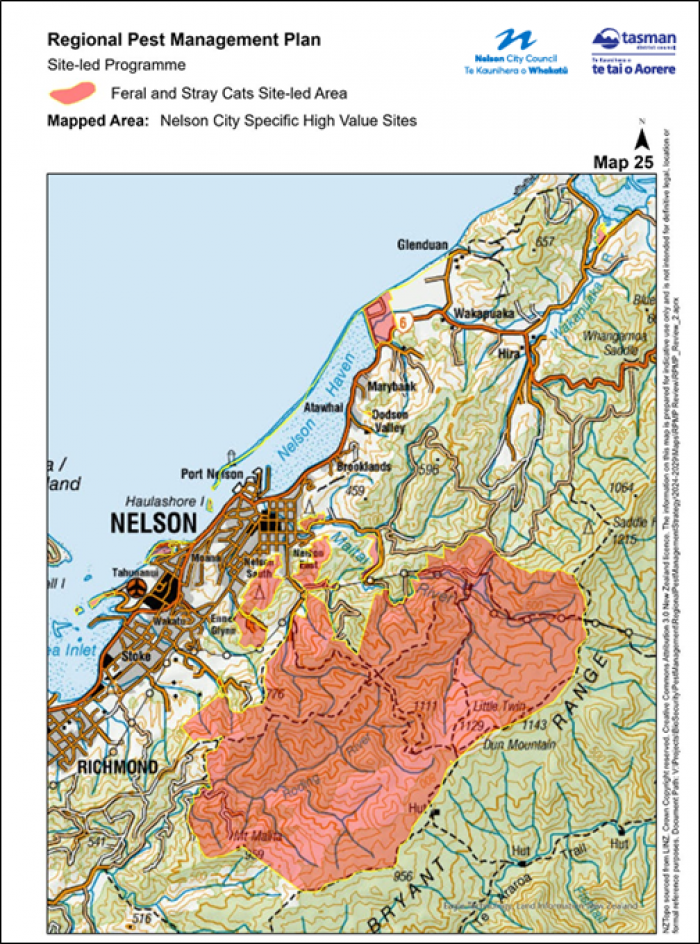
Abel Tasman National Park – no change to maps
St Arnaud
Please note, this area is slightly different to the existing area for the St Arnaud site-led weed programme.

Identify pest ground covers and grass invaders which are included in the Tasman-Nelson Regional Pest Management Plan.
The brochure containing this information is available below:
Landowners are responsible for managing pests that are listed in the Regional Pest Management Plan, on the land that they own.
Sabella, or Mediterranean fan worm (Sabella spallanzanii )
Management category: Eradication
Rationale for inclusion: This amendment aligns with the Marlborough RPMP and therefore provide consistency across the Top of the South’s coastal marine areas. There are three additional Sabella control rules included which provide a backstop ability for the Councils to undertake enforcement action if and when compliance situations arise.
The eradication goal requires owners of vessels and marine equipment (craft) entering the region to not exceed a standardised fouling level of 2, (as developed by the Cawthron Institute), and for owners/occupiers of places to destroy Sabella when directed to by an authorised person.
Read the level of fouling guidance from Cawthron. (pdf 3.7 MB)
Plan rules and explanations of rules:
Specific Rules for Sabella In The Tasman-Nelson Region
Over the duration of this Plan:
i) The craft is entering Tasman-Nelson for the purpose of hauling out. The haul out must be undertaken within 24 hours of arriving. Proof via receipt from a haul out facility must be provided to an Authorised Person if requested, or
ii) The craft is entering Tasman-Nelson for emergency purposes and the craft leaves the region within 24 hours of arrival (or otherwise the occupier needs to comply with the rule), or
iii) The craft is required to enter Tasman-Nelson in response to a declaration of a state of emergency, as determined by the Ministry of Civil Defence & Emergency Management.
Rule a. does not apply to marine craft that have entered New Zealand waters in compliance with the Craft Risk Management Standard (CRMS) for Biofouling in the period two months prior to either directly or subsequently entering Tasman-Nelson waters.
Rule a. is also not intended to apply to those craft that are usually moored in the Tasman-Nelson region and leave the region for no more than 72 hours before returning.
Level 2 macrofouling (e.g. having goose barnacles) is defined by the Cawthron Institute as: macrofouling is present in small patches, or a few isolated individuals or small colonies, and covers between 1 - 5% of the visible surface.
In relation to receipt verification from haul out facilities, this will need to be from a recognised haul out facility (i.e. the Top of the South has a list of recognised facilities) or proof that the facility complies with the respective council's consent rules.
b. The occupier or person in charge of any place (e.g. marine craft or structure) shall destroy Sabella that has been found on that place, on written direction from an Authorised Person, unless there is an approved agreement in place between the Management Agency and occupier as an alternative way to achieve this requirement.
c. In undertaking steps to destroy Sabella (under rule b.), the place shall first be slipped or contained within an encapsulation system and treated with biocode. If that is not practicable, Sabella may be removed in water by divers who are appropriately trained and all Sabella must be contained and returned to the surface for disposal to a suitably authorised facility.
Marine craft that have been hand cleared of sabella by divers under rule c. (i.e. where treated in-situ within TDC’s jurisdiction) are permitted to stay at the site of treatment for a maximum of one month following treatment. After this period craft are required to be slipped and fully cleaned, to the satisfaction of an authorised person. There is a boat haul out facility with Port Nelson.
d. Any person who suspects they have observed Sabella in Tasman-Nelson shall notify the Management Agency within 24 hours of making the observation, detailing the location and situation of the suspected pest.
Rule d. applies as Sabella is also a notifiable organism through the Biosecurity (Notifiable Organisms) Order 2016. The suspected presence of Sabella must also be reported to the Ministry for Primary Industries in accordance with section 46 of the Biosecurity Act 1993.
Moth plant Araujia sericifera syn. A. hortorum

|
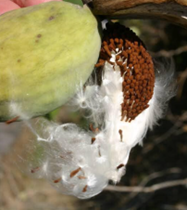
|
Moth plant is a native vine to South America which has become a significant pest weed in many regions of New Zealand. We are fortunate in Tasman and Nelson, as moth plant is found in very low numbers and is largely restricted to a few residential properties. Moth plant vines smother native vegetation and exclude light required by the host trees for photosynthesis. They have the potential to catastrophically impact forest structure. The vine produces a poisonous milky latex in its stems, leaves and roots which can cause dermatitis and eye irritation.
General description
Moth plant is a perennial climbing vine containing milky sap/latex. Its stems are twining, scrambling and woody. Leaves are entire, < 10 cm long and opposite, with dull green tops and grey undersides. Flowers are white/pale pink and borne singly or in clusters. Its fruit is fleshy, leathery and pear-shaped. The vine’s seeds are formed in pod-like structures, and each seed within the pod contains a papas (like a thistle seed) which enables easy dispersal by wind. Water can also be another pathway for dispersal.
In 2024, moth plant was added to the Tasman-Nelson Regional Pest Management Plan as part of a review update. Its status in the Plan is “Eradication” and the aim is to completely eradicate this pest vine from our two regions. Please report any sighting of this vine to the Biosecurity Department of either Tasman District Council for discoveries in Tasman, or Nelson City Council for discoveries in Nelson. Do not attempt to undertake control of this species, as Biosecurity staff are required to record each find and undertake the control work.
You must not propagate, distribute, release or sell moth plant. As moth plant is a National Pest Plant Accord species, these restrictions apply within the Tasman/Nelson regions and across the whole of New Zealand.
Pampas grass – common pampas (Cortaderia selloana) and purple pampas (Cortaderia jubata) - Golden Bay sites only
Previous status: Not a named pest in current RPMP.
New Management category: Sustained Control programme in two areas in Golden Bay – the Aorere Valley (lower area) and Whanganui Inlet to Puponga (upper area) – refer to the map below.
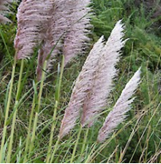 Rationale for inclusion: Both species are well established and widely spread through much of the lowlands of Tasman District and Nelson City areas. Since 2019, when pampas was removed from the previous RPMP, biosecurity officers have noted a marked increase in the incidence of the pest. However, parts of the Aorere Valley and the western coast of Golden Bay around Westhaven remain relatively free of pampas. Pampas is likely to continue to spread into these areas if unmanaged, affecting the indigenous biodiversity values of bush margins, indigenous grasslands, escarpments and wetlands in these areas.
Rationale for inclusion: Both species are well established and widely spread through much of the lowlands of Tasman District and Nelson City areas. Since 2019, when pampas was removed from the previous RPMP, biosecurity officers have noted a marked increase in the incidence of the pest. However, parts of the Aorere Valley and the western coast of Golden Bay around Westhaven remain relatively free of pampas. Pampas is likely to continue to spread into these areas if unmanaged, affecting the indigenous biodiversity values of bush margins, indigenous grasslands, escarpments and wetlands in these areas.
It is proposed to include both species of pampas, otherwise staff would be left ‘splitting hairs’ on which species is which. Also, visually, the public see pampas as pampas, not as C. jubata or C. selloana. Both species have a negative impact on environmental and production values.
Description and adverse effects: Pampas are large-clump forming grasses that can grow up to 3m-4m tall. Pampas can be distinguished from the native toetoe (Austroderia species) by its more erect and fuller flower head that is white to pinkish (C. selloana) or has a purple tinge (C. jubata) rather than cream coloured.
 Pampas species are hardy and tolerant plants making them highly adaptable to a range of habitats including forest light gaps, slips and other disturbed sites (including sprayed or burned sites), river and forest margins, cliffs, shrublands, tussockland, fernland, herbfields, salt marshes, and wetlands. They colonise quickly and can become very dense, effectively out-competing indigenous species to replace ground cover species and shrubs. Pampas tends not to invade grazed pastures, but can quickly invade retired pasture and over-run restoration planting sites. Seeds are spread very long distances by wind (up to 25km) and occasionally by water, soil movement, contaminated machinery, clothing and on animal pelts.
Pampas species are hardy and tolerant plants making them highly adaptable to a range of habitats including forest light gaps, slips and other disturbed sites (including sprayed or burned sites), river and forest margins, cliffs, shrublands, tussockland, fernland, herbfields, salt marshes, and wetlands. They colonise quickly and can become very dense, effectively out-competing indigenous species to replace ground cover species and shrubs. Pampas tends not to invade grazed pastures, but can quickly invade retired pasture and over-run restoration planting sites. Seeds are spread very long distances by wind (up to 25km) and occasionally by water, soil movement, contaminated machinery, clothing and on animal pelts.
Plan rules:
Specific Rule For Common and Purple Pampas In The Tasman-Nelson Region
Over the duration of this Plan:
a. Occupiers in Golden Bay (within the Sustained Control areas - Aorere Valley and Whanganui Inlet to Puponga) as shown on the map must destroy any common and purple pampas on their land, on an annual basis, prior to the completion of flowering.
b. Occupiers in Golden Bay (adjoining the Sustained Control areas - Aorere Valley and Whanganui Inlet to Puponga) as shown on the map must destroy any pampas within 200m of their property boundary (before completion of flowering) where the adjoining occupier (within the Sustained Control area) is taking reasonable steps to destroy pampas on the adjoining land. This is a Good Neighbour Rule.
A breach of this rule is an offence under Section 154N(19) of the Act.

Pest animals is a category that includes introduced animals, birds, fish and insects.
Most introduced birds are widespread and have become well established. However, there is concern about the impact on horticultural crops posed by birds such as rooks that have not yet become established. For this reason, they have been included in the Tasman-Nelson Regional Pest Management Plan and rural landowners undertake an active surveillance campaign to spot any rooks.
At this stage, there are no known rookeries in the district. Further information on rooks and magpies can be found in the Regional Pest Management Plan.
Animals that are considered a pest to many rural landowners (e.g. pigs, deer) because of the damage they do to native vegetation may be a valuable resource to hunters. Others that may pose a risk to cattle by transmitting Bovine Tb (e.g. possums) can also provide some economic benefits to trappers in accessible areas. Most rural landowners consider animals such as goats, ferrets, stoats and weasels as pests and may trap them to protect native vegetation and native birds.
In Tasman District, possums, feral cats, feral rabbits, hares, ferrets, stoats and weasels have been included in the Regional Pest Management Plan (RPMP) as Containment pests, where control by landowners is needed to reduce their numbers and slow their spread to adjoining properties and to other parts of the region.
Identify pest insect invaders, some of which are included in the Tasman-Nelson Regional Pest Management Plan.
The brochure containing this information is available below:
Identify pest shrub invaders, some of which are included in the Tasman-Nelson Regional Pest Management Plan.
The brochure containing this information is available below:
Identify pest tree invaders, some of which are included in the Tasman-Nelson Regional Pest Management Plan.
The brochure containing this information is available below:
Identify pest vine invaders, some of which are included in the Tasman-Nelson Regional Pest Management Plan.
The brochure containing this information is available below:
If you are keen to carry out pest animal control on your property, you can purchase a subsidised pest trap through our backyard trapping programme.
Available traps are as follows:
These traps will provide their owners with many years of service. The rat and DOC200 trap mechanisms are housed in strong wooden boxes, and a Council subsidy gives a 50 percent saving on the cost of manufacturing and materials.
These prices only apply to Tasman District Council traps bought in Tasman District or Nelson City. Nelson City Council also sell traps which may be priced differently.
Our subsidised traps can now be purchased by Tasman residents at the following locations:
To ensure these traps are available for all Tasman residents, there is a limit of one of each trap type per property.
We would like to thank the great team at the Waimea Menzshed for building the trap boxes for us.
For more information or to purchase a trap, get in touch with one of our service centres.

Taiwan cherry tree and flowers
Taiwan cherry (Prunus campanulata) is a deciduous species of cherry tree native to Taiwan. It is a small-sized tree, up to 10 m high, with alternate, thin green leaves that are 5-17 cm long, with sharply-toothed margins.
Taiwan cherry is a relative newcomer to the Tasman-Nelson region, with the first trees being brought here during the mid-1960s. It has since been widely grown as an amenity tree and its popularity has increased markedly over the past 20 years. From late July through to early September, mature trees produce thousands of appealing dark pink flowers that attract pollinators such as bees and tui. From the outset, this makes it a desirable ornamental specimen tree for people to plant.
Because Taiwan cherry produces flowers in late winter/early spring, flower fertilisation by pollinators is particularly high. These fertilised flowers produce small, astringent, fleshy cherries with a stony centre, about 10-12 mm in diameter. These fruits are eagerly sought by birds such as wax eyes, starlings, blackbirds and native pigeons, who spread them to other areas, such as regenerating native scrublands, in their droppings. Other animals, such as possums and pigs may also spread the seed in the same manner. The seeds have a particularly high germination rate.
Unlike other cherry species, a Taiwan cherry seed has the ability to germinate in low light where it produces a very shade tolerant seedling.
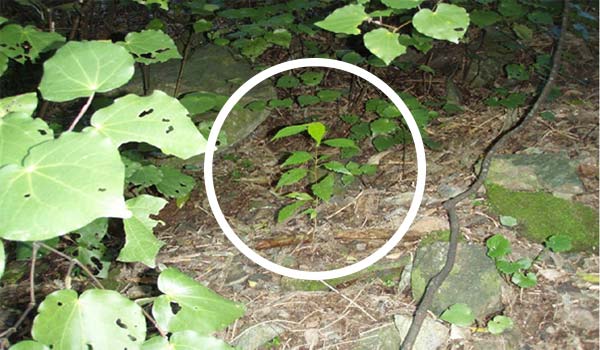
Taiwan cherry are shade tolerant and after just one year are difficult to pull out by hand.
With its characteristic single leader growth form, it is able to push up through overhead cover, eventually producing a cone-shaped configuration.
Unlike all other woody weeds in Nelson-Tasman, except perhaps Douglas fir, Taiwan cherry is able to invade not only exotic scrub mixtures, but also native scrublands, where it can over-top native mahoe trees that may also be emerging through this scrub.
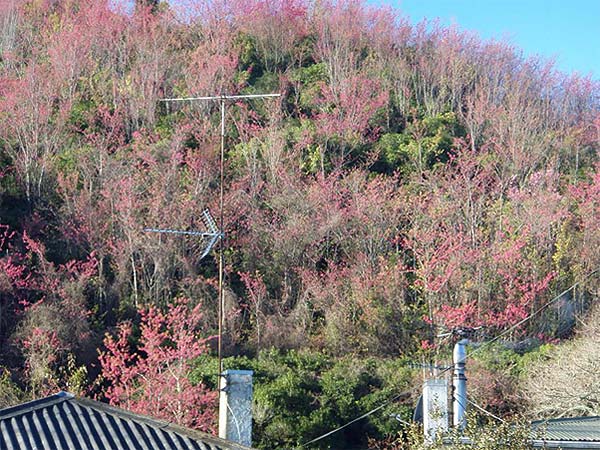
Taiwan cherry can proliferate quickly - this picture from Dodson Valley shows the trees crowding out native growth
In Dodson Valley in north Nelson, Taiwan cherry spread at an alarming rate to the surrounding hillsides, where it dominated the native vegetation. The scrubland forest floor of these hillsides contained thousands of seedlings, which in recent years have been brought under control by contractors at considerable expense. This infestation resulted from one single specimen tree in a backyard property adjacent to the hill country.
Unless Taiwan cherry is controlled now, it will be extremely difficult to eradicate. This video shows the significant quantities of these pest trees on the roadside near Paihia, in the Bay of Islands.
Taiwan cherry seedlings are deep rooted and after just one year cannot be hand-pulled. Seedlings can be sprayed with glyphosate (Roundup) when in full leaf. Larger trees can be cut off at ground level, although the stump must be treated with a glyphosate gel to kill the root system. If this is not done, coppicing from the base will occur (forming a new tree). Trees can also be killed by drilling holes in the trunk and filling them with full strength glyphosate.
In other regions of the country, particularly the North Island, Taiwan cherry has become widespread and has been banned from sale, propagation and distribution by several local authorities. In areas such as Northland, Taiwan cherry now dominates many scrubland areas, and is considered too difficult to eradicate. Considering that the first naturalised (wilding) record for all of NZ was only in 1988, the rate of spread has been extraordinary.
If you have purchased a Taiwan cherry tree in the past, our biosecurity staff will remove it at no cost, and for cooperative landowners, we can approve a replacement tree for each Taiwan cherry removed, up to the value of $75 per tree.
Taiwan cherry does not cause issues in its native country, Taiwan, as it is kept “in check” by a range of native pathogens and insect vectors that predate upon it.
Opportunities to introduce some of these pathogens / insect vectors as biocontrol agents are probably very limited in NZ, given that plums, cherries, peaches, nectarines, apricots, and almonds are in the same genus (Prunus family). The potential risk to these other fruit and nut bearing trees by intentionally introduced Taiwan cherry biocontrol agents (if it was to be considered) would need to be carefully assessed.
Tasman District Council Biosecurity staff have visited a number of other sites in Tasman where naturalised spread is just starting to manifest. We are not too late at this stage to attempt eradication, but we need the support and cooperation of our local communities to achieve this goal.
It is important that Council is notified of sites where Taiwan cherry is, or has been planted in the past, as seedlings may have spread from these locations to neighbouring properties. The property occupiers around a Taiwan cherry site will need to remain vigilant and know how to identify and remove seedlings for a number of years (seed viability is unknown, but is possibly no more than 5 years).
We appreciate that these trees are attractive and that they draw in tuis and bees, but these benefits are far outweighed by the disastrous ecological impacts this tree will have on our indigenous scrubland and forest ecosystems if left to spread.
The Nelson-Tasman Regional Pest Management Plan 2019-2029 seeks to eradicate this tree over the life of the Plan, and it is now illegal to sell, propagate or distribute Taiwan cherry in the Tasman-Nelson region.
To report a Taiwan cherry tree or for further information phone or email the Tasman District Council or the Nelson City Council.
Tasman District Council: Phone 03 543 8400
Nelson City Council: Phone 03 546 0200
The Taiwan cherry problem - Dr Peter Williams.pdf (pdf 2.6 MB)
Water celery (Helosciadum nodiflorum) and Vietnamese parsley (Oenanthe javanica)
Management category: Sustained control programme for whole region for both species. They are listed together for management purposes as the approach taken is the same for both plants.
 Rationale for inclusion in the Tasman-Nelson RPMP: Water celery and Vietnamese parsley are in the early stages of naturalisation in Nelson City and Tasman District. While the abundance of both plants is relatively low there is a large invasion potential in regional waterways. Current infestations are beyond the eradication stage and ability. Trials to control incursions have been successful at reducing the size of infestatioins, buthave not yet proven to be able to eliminate them completely.
Rationale for inclusion in the Tasman-Nelson RPMP: Water celery and Vietnamese parsley are in the early stages of naturalisation in Nelson City and Tasman District. While the abundance of both plants is relatively low there is a large invasion potential in regional waterways. Current infestations are beyond the eradication stage and ability. Trials to control incursions have been successful at reducing the size of infestatioins, buthave not yet proven to be able to eliminate them completely.
Both plants are best managed to reduce impacts on the biodiversity values of waterways, with obligations on occupiers ti undertake control. A ‘check, clean, dry’ tyoe rule, with awareness, will also help to reduce the soread and impacts beyond current areas.
Description and adverse effects:
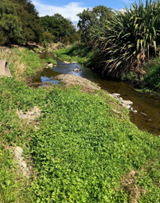
Water celery smothering stream margins
Water celery is an aquatic herb that appears to be reliant on human activity to disperse fragments. While not cultivated as a culinary herb it can be mistaken for watercress (Nasturtium officinale). It is widespread in the North Island, though rare in the South Island. It regrows readily from stem segments and prolific seed. It can have negative impacts on river recreational (fishing and swimming), infrastructural (drainage), and environmental (aquatic biodiversity) values by clogging small streams and waterways.

Vietnamese parsley in Poorman Valley Stream
Vietnamese parsley is an aquatic herb cultivated as an ornamental and culinary herb species. It was first recorded as successfully establishing in the wild in 2014. It regrows readily from stem segments. It impacts on river recreational (fishing and swimming), infrastructural (drainage), and environmental (aquatic biodiversity) values by clogging small streams and waterways.
Plan rules:
Within the Tasman-Nelson region occupiers must:
a. Destroy any water celery and Vietnamese parsley on their land, on the written direction of an authorised person, on an annual basis, prior to the onset of flowering.
b. Remove all fragments of water celery and Vietnamese parsley from their places (i.e. machinery, equipment and craft that have been in ciontact with waterway vegetaton) when leaving infested waterways.
German wasps arrived in NZ about 60 years ago and common wasps arrived about 20 years ago. They have had a dramatic effect on a range of native birds and insects, competing for nectar with birds such as tuis and bellbirds, and killing large numbers of native insects.
Some people react strongly to wasp stings and multiple stings can lead to serious harm or death.
If you have any concerns about wasp nests, please Contact the Biosecurity Team.
Weeds are pest plants (usually introduced) that compete with productive plants (eg clover, grass, horticultural crops) or with indigenous plants. They compete by slowing their growth, shading them out or preventing regeneration of seedlings. Weeds can be controlled by physical removal (grubbing or cutting) or by herbicides (applied internally or externally).
In Tasman, gorse and broom are widespread, having been introduced and spread by early landowners and by animals and birds. The widespread use of fire to control pasture that was reverting to bracken and woody vegetation eliminated much of the competition for these weeds. The long-term viability of gorse and broom seed (more than 20 years in the ground) make it an extremely difficult plant to eradicate.
Some weeds pose a much greater threat than others. Responsibility for controlling weeds that pose the greatest threat lies with Biosecurity NZ, a department of the Ministry of Agrciulture and Forestry. Weeds that post a significant threat to economic or ecological values are usually included in regional pest management plans.
The Tasman-Nelson Regional Pest Management Plan lists 37 species of weeds under four different categories. These are weeds where the Council is satisfied that the costs of controlling them is justified by the benefits that this will bring. High-risk weeds with a very limited distribution are usually targeted for eradication. Weeds with a wider distribution may be progressively controlled to reduce their density and/or distribution. Widely-distributed weeds may be subject to boundary control to protect landowers with clean properties from being re-invaded from neighbouring properties.
The following website pages have more information which you may find useful:
Introduced fish such as trout and salmon provide recreational benefits to many anglers and are the basis of many a fine meal. There are other introduced freshwater fish such as koi carp, perch, rudd, and tench that could provide some sporting benefit to fisherman, but this would be outweighed by their impact on waterbodies.
Within Tasman District, the Department of Conservation have undertaken an active campaign against them and other fish such as Gambusia. For this reason, they have been included in the Regional Pest Management Plan. Further information on pest fish is contained in the Regional Pest Management Plan.
This section describes aquatic and wetland invaders as identified in the Tasman-Nelson Regional Pest Management Plan.
Please note that most aquatic and wetland plants are dispersed by stem or root fragments, so care should be taken when removing such plants to remove all material. Consider carefully what plants you buy for ponds and aquariums. If unsure, check with a Biosecurity Officer. Never dump aquarium contents or water into stormwater drains or water ways.
Read more about controlling pests in this brochure:
Controlling Aquatic and Wetland Invaders Booklet.pdf (pdf 1.3 MB)